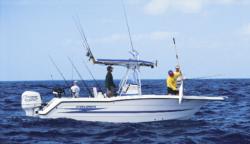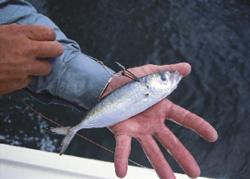Fly high for kingfish
Kite fishing teases, pleases predators

Ask Captain Allen Winchel for advice on catching kingfish, and he’ll tell you to go fly a kite – literally. Deploying baits from an aerial operation proves highly effective in tempting the finned scissors known scientifically as Scomberomorus cavalla.
In most places kings roam, traditional live-bait slow-trolling techniques work just fine. But Winchel’s many years of South Florida sailfishing has taught the Team Hydra-Sports angler that nothing brings predators topside better than a lively baitfish tap dancing on the surface.
“It’s the ultimate teaser,” Winchel said. “The bait’s constantly trying to go down, because the line is restricting him and holding him up. I think just having baits out there struggling, as opposed to a flat line where they can get lazy and just lay there, gets the predators excited.”
Consider a teaser’s duty: Put on a big show and influence predators to come closer. Many artificial gadgets will look the part, but say a hungry fish slides in for a sniff and a nibble. Will that artificial teaser smell, taste and feel like the real deal? Nope. The kite bait will. And when a fired-up kingfish makes its move, the teaser becomes a pleaser, and Mr. Predator feels pretty good about his decision to sink a mouthful of formidable choppers into a real meal. That is, until the teaser bites back.
Even if your kite bait never draws a strike, it’s a safe assumption that some fish will rise to the commotion but actually elect to strike other offerings in your spread. If kingfishing were basketball, the kite would consistently post high-assist stats.
Moreover, kite baits will also give you a preview of coming attractions, Winchel said. From sailfish strolling topside to bill-whack the bait, to kingfish skyrocketing 20 feet above the froth where the suspended bait once swam, kiting elevates the visual appeal of the sport.
Much of kiting’s effectiveness depends upon the main course. For maximum display, Winchel looks for the plumpest, orneriest little fish he can find. Likely candidates include jacks, blue runners, goggle eyes and mullet. Lighter baits, like pilchards, sardines and threadfin herring are great for flat lines and downriggers, but a kite negotiating with a stiff breeze would yank the little guys out of the water with every puff.
The setup
 A kite rod – specific product or a homemade deal – deploys a kite trailing heavy line with release clips from which fishing lines are suspended. Winchel’s kite rod is a cut-off grouper stick strapped with a heavy-duty conventional reel carrying about 100 yards of 80- to 100-pound mono, although 60- to 80-pound Dacron also works. It’s definitely a beefy outfit, but such strength earns its oats when conditions turn puffy.
A kite rod – specific product or a homemade deal – deploys a kite trailing heavy line with release clips from which fishing lines are suspended. Winchel’s kite rod is a cut-off grouper stick strapped with a heavy-duty conventional reel carrying about 100 yards of 80- to 100-pound mono, although 60- to 80-pound Dacron also works. It’s definitely a beefy outfit, but such strength earns its oats when conditions turn puffy.
“My suggestion is to use the biggest reel you can find for the cranking power,” Winchel said. “When the wind is strong, it’s hard to crank that kite in. That’s why some boats use electric reels – it’s basically for the power.”
Specific techniques vary among seasoned kite fishermen, but explaining basic rigging is simpler in reverse order. Starting at the kite line’s terminal end, a heavy-duty snap swivel connects the line to the kite. Moving back toward the rod, two release clips slide freely on the line. The clip nearest the kite has the smallest base hole, and the clip nearest the rod tip has the largest.
To move the freestanding release clips off the rod tip and skyward with the rising kite, Winchel ties two barrel swivels into the kite line. The first swivel, about 50 feet from the terminal end, is the smallest. When running off the rod tip, this swivel passes through the first clip (the one with the larger hole), catches in the smaller hole of the second release clip and carries it upward. The second barrel swivel, about 75 feet from the first, is the largest. This swivel catches the second release clip and carries it into duty.
In this order, Winchel secures the bait lines into the release clips, sets the fishing reel in open clicker, backs off the kite reel’s drag and thumbs both spools. This routine allows him to evenly release both lines and set the kite and fishing line to the ideal positions where the bait suspends just deep enough to breathe, but so shallow it constantly splashes. Given the relentless beating inflicted from the kite line swivels, the kite rod’s eyes must be stainless steel. Graphite eyes won’t last one trip.
To monitor each bait’s distance and depth, neon pink, green or orange marker corks are placed above the swivel connecting running line to leader. Easier to spot than thin mono or a release clip, the markers remain at a constant distance from the bait, thereby providing a standard reference point above the surface. For quick responses, wrap a piece of tape or yarn matching the marker’s color onto its corresponding rod. On a strike, grabbing the correct rod often makes or breaks the effort.
Other marking devices include brightly colored yarn, ribbons or small, round balloons. On a strike, the fishing line falls from the clip, the marking device submerges and the battle ensues.
To cover their bases, most kite fishermen carry an assortment of kite sizes to work with light to heavy winds. For dead-calm days, round helium balloons, filled via portable tanks, will keep the show going.
Kiting works from an anchored boat, but drifting is best, as it obviously covers more water. Plus, drift kiting enables fishermen to work both sides of the boat – kites off the leeward gunnel, flatlines, surface floats and downriggers off the windward side. This prevents kites and their fishing lines from being blown into, across or over the boat – a bad deal either way.
Properly managed, kite-fishing spreads will cover the water column and provide kingfish with many options when all that surface thrashing becomes too enticing to ignore.
Kite fishermen find many of their baits by jigging with gold-hook Sabiki rigs around channel markers and over hard bottom. Rig sizes vary and should be matched to the targeted baits. For example, drop a light rig with 8-pound main line and 6-pound branch line where jumbo blue runners roam, and you’re just going to get your feelings hurt when the brutish baitfish rip off all your hooks. Likewise, drop blue runner-sized rigs in a school of pilchards or threadfin herring and the baits will have a tough time getting their mouths around the larger hooks.
Also consider the depth, as well as current strength and direction. In slow, shallow water, an ounce of lead will get your rig to the bottom. If the current is cranking, 2 to 3 ounces is better. Likewise, when jigging buoys and fixed markers, study how and where the water will carry your rig before letting it fly. Remember that the anchoring devices that keep floating markers in place have an appetite for wayward tackle.
In another scenario, open-water bait schools won’t sit still long enough for a boat to drift into their midst. The option is slinging a Sabiki rig into the pod. But again, consider the water’s strength. In a swift flow, Sabikis cast at an angle typically sink a few feet, lose momentum and start drifting laterally in the current.
Furthermore, try not to let the weight hit the school dead-center or the bait will sound in a hurry when the one with a headache warns all his buddies.
